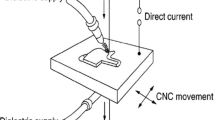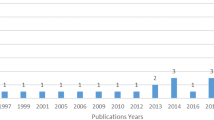Abstract
In the present research, wire electrical discharge machining (WEDM) of γ titanium aluminide is studied. Selection of optimum machining parameter combinations for obtaining higher cutting efficiency and accuracy is a challenging task in WEDM due to the presence of a large number of process variables and complicated stochastic process mechanisms. In general, no perfect combination exists that can simultaneously result in both the best cutting speed and the best surface finish quality. This paper presents an attempt to develop an appropriate machining strategy for a maximum process criteria yield. A feed-forward back-propagation neural network is developed to model the machining process. The three most important parameters – cutting speed, surface roughness and wire offset – have been considered as measures of the process performance. The model is capable of predicting the response parameters as a function of six different control parameters, i.e. pulse on time, pulse off time, peak current, wire tension, dielectric flow rate and servo reference voltage. Experimental results demonstrate that the machining model is suitable and the optimisation strategy satisfies practical requirements.
Similar content being viewed by others
References
Scott D, Boyina S, Rajurkar KP (1991) Analysis and optimization of parameter combinations in wire electrical discharge machining. Int J Prod Res 29:2189–2207
Tarng YS, Ma SC, Chung LK (1995) Determination of optimal cutting parameters in wire electrical discharge machining. Int J Mach Tools Manuf 35:1693–1701
Liao YS, Huang JT, Su HC (1997) A study on the machining – parameters optimisation of wire electrical discharge machining. J Mater Process Technol 71:487–493
Spedding TA and Wang ZQ (1997) Study on modeling of wire EDM process. J Mater Process Technol 69:18–28
Karthikkeyan R et al. (1999) Mathematical modeling for electric discharge machining of aluminum – silicon carbide particulate composites. J Mater Process Technol 87:59–63
Huang JT, Liao YS, Hsue WJ (1999) Determination of finish-cutting operation number and machining parameters setting in wire electrical discharge machining. J Mater Process Technol 87:69–81
Tsai KM, Wang PJ (2001) Predictions on surface finish in electrical discharge machining based upon neural network models. Int J Mach Tools Manuf 41:1385–1403
Voice W (1999) Future use of gamma titanium aluminides by Rolls-Royce. Aircraft Eng Aero Technol 71(4):337–340
Guedes A, Pinto AMP, Vieira M, Viana F, Ramos AS, Vieira MT (2002) Microstructural characterization of γ-TiAl Joints. Key Eng Mater 230-232:27–30
Pan B, Kim DJ, Kim BM, Dean TA (2001) Incremental deformation and the forgeability of γ titanium aluminide. Int J Mach Tools Manuf 41:749–759
Sharman ARC, Aspinwall DK, Dewes RC, Clifton D, Bowen P (1973) The effects of machined workpiece surface integrity on the fatigue life of γ-titanium aluminide. Int J Mach Tools Manuf 41:1681–1685
Zaltin N, Field M (1973) Procedures and precautions in machining titanium alloys. Titanium Sci Technol 1:489–504
Bentley SA, Mantle AL, Aspinwall DK (1999) The effect of machining on the fatigue strength of a gamma titanium aluminide intermetallic alloy. Intermetallics 7:967–969
Dauw DF, Sthioul H, Delpretti R, Tricarico C (1989) Wire analysis and control for precision EDM cutting. Ann CIRP 38(1):191–194
Puri AB, Bhattacharyya B (2003) Modeling and analysis of the wire tool vibration in wire-cut EDM. Int J Mater Process Technol 141(3)295–301
Puri AB, Bhattacharyya B (2003) An analysis and optimization of the geometrical inaccuracy due to wire lag phenomenon in WEDM. Int J Mach Tools Manuf 43(2):151–159
Kao JY, Tarng YS (1997) A neural-network approach for the on-line monitoring of the electrical discharge machining process. J Mater Process Technol 69:112–119
Liao TW, Chen JL (1994) A neural network approach for grinding process: modeling and optimization. Int J Mach Tools Manuf 34:919–937
Fausett L (1994) Fundamentals of neural networks: architectures, algorithms and applications. Prentice-Hall, New York
Haykin S (2002) Neural networks: a comprehensive foundation. Pearson, Harlow
Author information
Authors and Affiliations
Corresponding author
Rights and permissions
About this article
Cite this article
Sarkar, S., Mitra, S. & Bhattacharyya, B. Parametric optimisation of wire electrical discharge machining of γ titanium aluminide alloy through an artificial neural network model. Int J Adv Manuf Technol 27, 501–508 (2006). https://doi.org/10.1007/s00170-004-2203-7
Received:
Accepted:
Published:
Issue Date:
DOI: https://doi.org/10.1007/s00170-004-2203-7




